Asia Pacific Economies: Economic Success and Models
VerifiedAdded on 2020/04/13
|12
|3139
|39
Essay
AI Summary
This essay critically analyzes the economic development of Asia Pacific economies, specifically focusing on the perspectives of Paul Krugman and Frank Gibney. It examines the growth of the Asian Tigers and Newly Industrializing Countries, questioning whether their success is a 'miracle' or a result of specific factors. The essay explores the role of high savings rates, export-oriented strategies, and the influence of Confucianism. It also delves into the debate of a single Asian recipe for economic success, comparing different models of industrialization and the impact of government intervention. The analysis considers factors such as foreign direct investment, government policies, and the role of education and human capital. The essay concludes by evaluating the East Asian model, its commonalities, and the contributions to the economic achievements of the region.
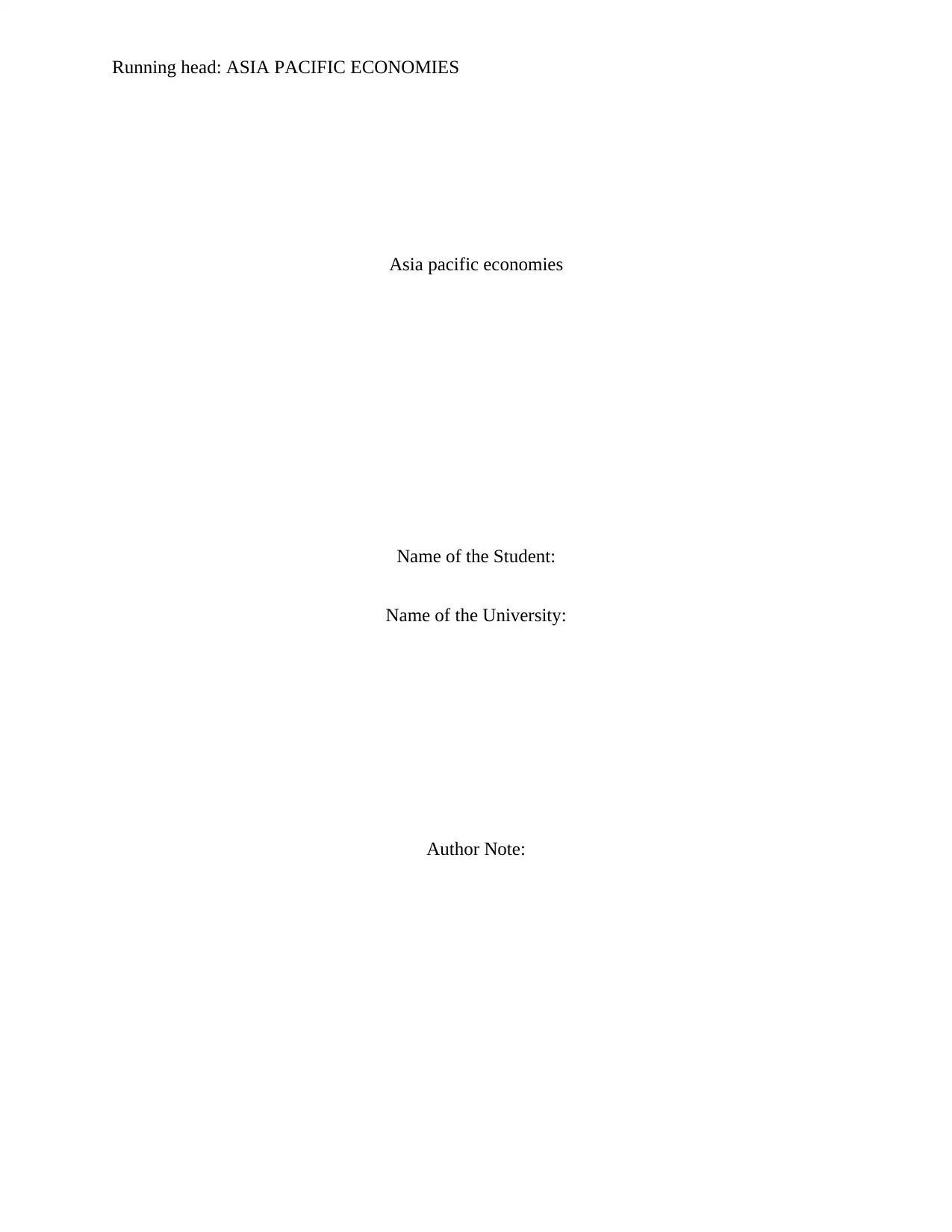
Running head: ASIA PACIFIC ECONOMIES
Asia pacific economies
Name of the Student:
Name of the University:
Author Note:
Asia pacific economies
Name of the Student:
Name of the University:
Author Note:
Paraphrase This Document
Need a fresh take? Get an instant paraphrase of this document with our AI Paraphraser

2ASIA PACIFIC ECONOMIES
Introduction
This study critically analyzes two articles to explain the issues revolving during recent
times. The title of the article are “The Myth of Asia’s Miracle” that was written by Paul
Krugman (Krugman, 1994). The title of the second journal article is “Letters to the Editor-
Asia’s Growth: Miracle or Myth” that was written by Frank Gibney (Husain, 1995). The current
essay had been written to highlight several issues and discussion had been made by referring the
above two articles in critical ways. It is the responsibility of the government who are engaging in
undertaking this opportunity for the support of financial expansion in these countries.
Furthermore, it is essential to look at the financial achievement lies in the fact that there have
been important attributes towards managing high rates of savings as well as investment. The
countries or economies have even pursued ways especially for export-oriented development
strategies in the most appropriate way (You, 2017).
Analysis
Is the growth experience of the Asian Tigers and the Newly-Industrializing Countries of
Southeast Asia in the latter half of the 20th century a myth or a miracle?
Despite its massive mobilization of resources, it is understood that Soviet economy was
treated as virtually certain so as to stop Soviet managers who were unable to utilize the resources
in an effective way (Preston, 2017). Likewise, it was argued by Krugman that paper tigers are
coasting on their astounding inputs without even increasing level of productivity in an effective
way. There are four newly industrialized economies in countries like Hong Kong, Taiwan as well
as Singapore and South Korea. Some important facts had been pointed out by World Bank
Introduction
This study critically analyzes two articles to explain the issues revolving during recent
times. The title of the article are “The Myth of Asia’s Miracle” that was written by Paul
Krugman (Krugman, 1994). The title of the second journal article is “Letters to the Editor-
Asia’s Growth: Miracle or Myth” that was written by Frank Gibney (Husain, 1995). The current
essay had been written to highlight several issues and discussion had been made by referring the
above two articles in critical ways. It is the responsibility of the government who are engaging in
undertaking this opportunity for the support of financial expansion in these countries.
Furthermore, it is essential to look at the financial achievement lies in the fact that there have
been important attributes towards managing high rates of savings as well as investment. The
countries or economies have even pursued ways especially for export-oriented development
strategies in the most appropriate way (You, 2017).
Analysis
Is the growth experience of the Asian Tigers and the Newly-Industrializing Countries of
Southeast Asia in the latter half of the 20th century a myth or a miracle?
Despite its massive mobilization of resources, it is understood that Soviet economy was
treated as virtually certain so as to stop Soviet managers who were unable to utilize the resources
in an effective way (Preston, 2017). Likewise, it was argued by Krugman that paper tigers are
coasting on their astounding inputs without even increasing level of productivity in an effective
way. There are four newly industrialized economies in countries like Hong Kong, Taiwan as well
as Singapore and South Korea. Some important facts had been pointed out by World Bank
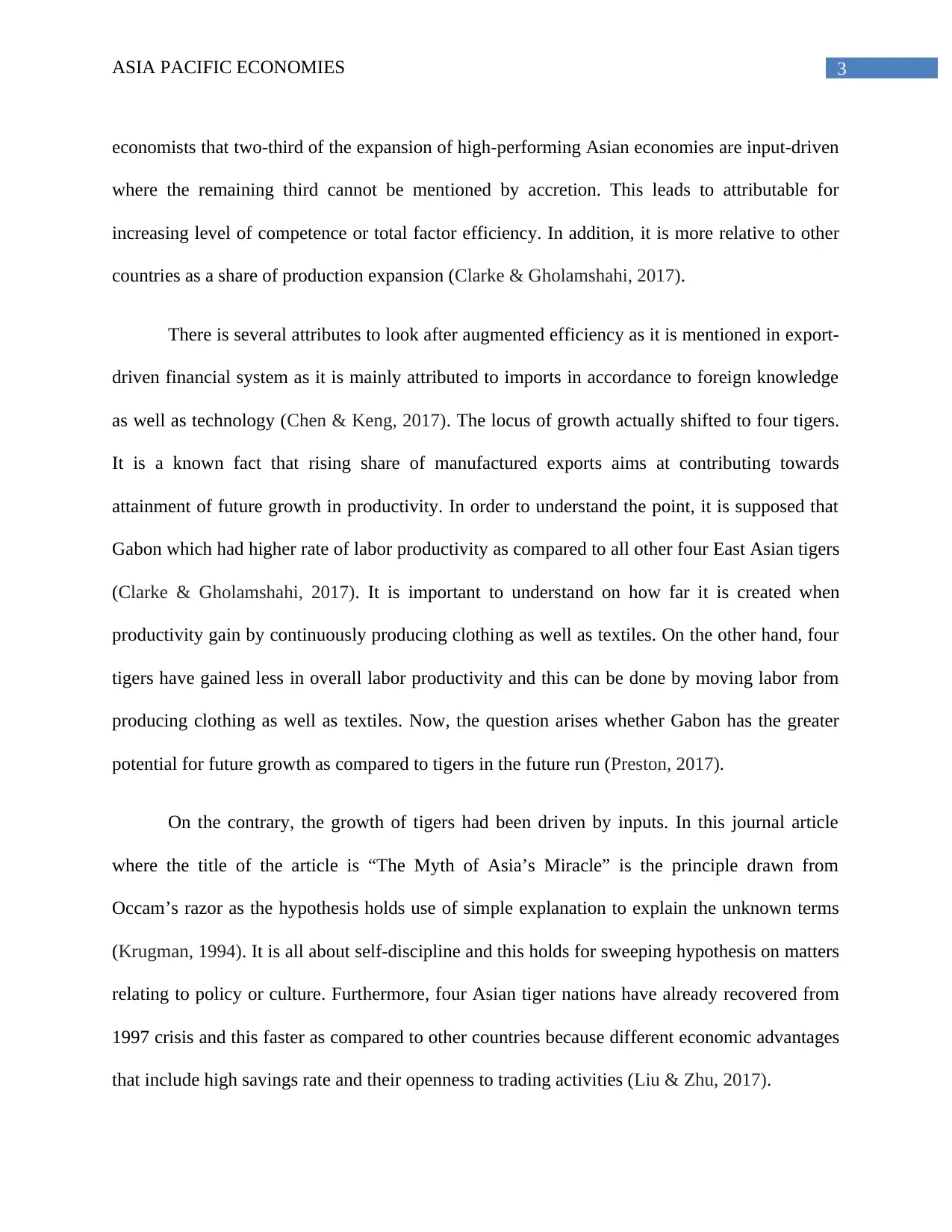
3ASIA PACIFIC ECONOMIES
economists that two-third of the expansion of high-performing Asian economies are input-driven
where the remaining third cannot be mentioned by accretion. This leads to attributable for
increasing level of competence or total factor efficiency. In addition, it is more relative to other
countries as a share of production expansion (Clarke & Gholamshahi, 2017).
There is several attributes to look after augmented efficiency as it is mentioned in export-
driven financial system as it is mainly attributed to imports in accordance to foreign knowledge
as well as technology (Chen & Keng, 2017). The locus of growth actually shifted to four tigers.
It is a known fact that rising share of manufactured exports aims at contributing towards
attainment of future growth in productivity. In order to understand the point, it is supposed that
Gabon which had higher rate of labor productivity as compared to all other four East Asian tigers
(Clarke & Gholamshahi, 2017). It is important to understand on how far it is created when
productivity gain by continuously producing clothing as well as textiles. On the other hand, four
tigers have gained less in overall labor productivity and this can be done by moving labor from
producing clothing as well as textiles. Now, the question arises whether Gabon has the greater
potential for future growth as compared to tigers in the future run (Preston, 2017).
On the contrary, the growth of tigers had been driven by inputs. In this journal article
where the title of the article is “The Myth of Asia’s Miracle” is the principle drawn from
Occam’s razor as the hypothesis holds use of simple explanation to explain the unknown terms
(Krugman, 1994). It is all about self-discipline and this holds for sweeping hypothesis on matters
relating to policy or culture. Furthermore, four Asian tiger nations have already recovered from
1997 crisis and this faster as compared to other countries because different economic advantages
that include high savings rate and their openness to trading activities (Liu & Zhu, 2017).
economists that two-third of the expansion of high-performing Asian economies are input-driven
where the remaining third cannot be mentioned by accretion. This leads to attributable for
increasing level of competence or total factor efficiency. In addition, it is more relative to other
countries as a share of production expansion (Clarke & Gholamshahi, 2017).
There is several attributes to look after augmented efficiency as it is mentioned in export-
driven financial system as it is mainly attributed to imports in accordance to foreign knowledge
as well as technology (Chen & Keng, 2017). The locus of growth actually shifted to four tigers.
It is a known fact that rising share of manufactured exports aims at contributing towards
attainment of future growth in productivity. In order to understand the point, it is supposed that
Gabon which had higher rate of labor productivity as compared to all other four East Asian tigers
(Clarke & Gholamshahi, 2017). It is important to understand on how far it is created when
productivity gain by continuously producing clothing as well as textiles. On the other hand, four
tigers have gained less in overall labor productivity and this can be done by moving labor from
producing clothing as well as textiles. Now, the question arises whether Gabon has the greater
potential for future growth as compared to tigers in the future run (Preston, 2017).
On the contrary, the growth of tigers had been driven by inputs. In this journal article
where the title of the article is “The Myth of Asia’s Miracle” is the principle drawn from
Occam’s razor as the hypothesis holds use of simple explanation to explain the unknown terms
(Krugman, 1994). It is all about self-discipline and this holds for sweeping hypothesis on matters
relating to policy or culture. Furthermore, four Asian tiger nations have already recovered from
1997 crisis and this faster as compared to other countries because different economic advantages
that include high savings rate and their openness to trading activities (Liu & Zhu, 2017).
⊘ This is a preview!⊘
Do you want full access?
Subscribe today to unlock all pages.

Trusted by 1+ million students worldwide
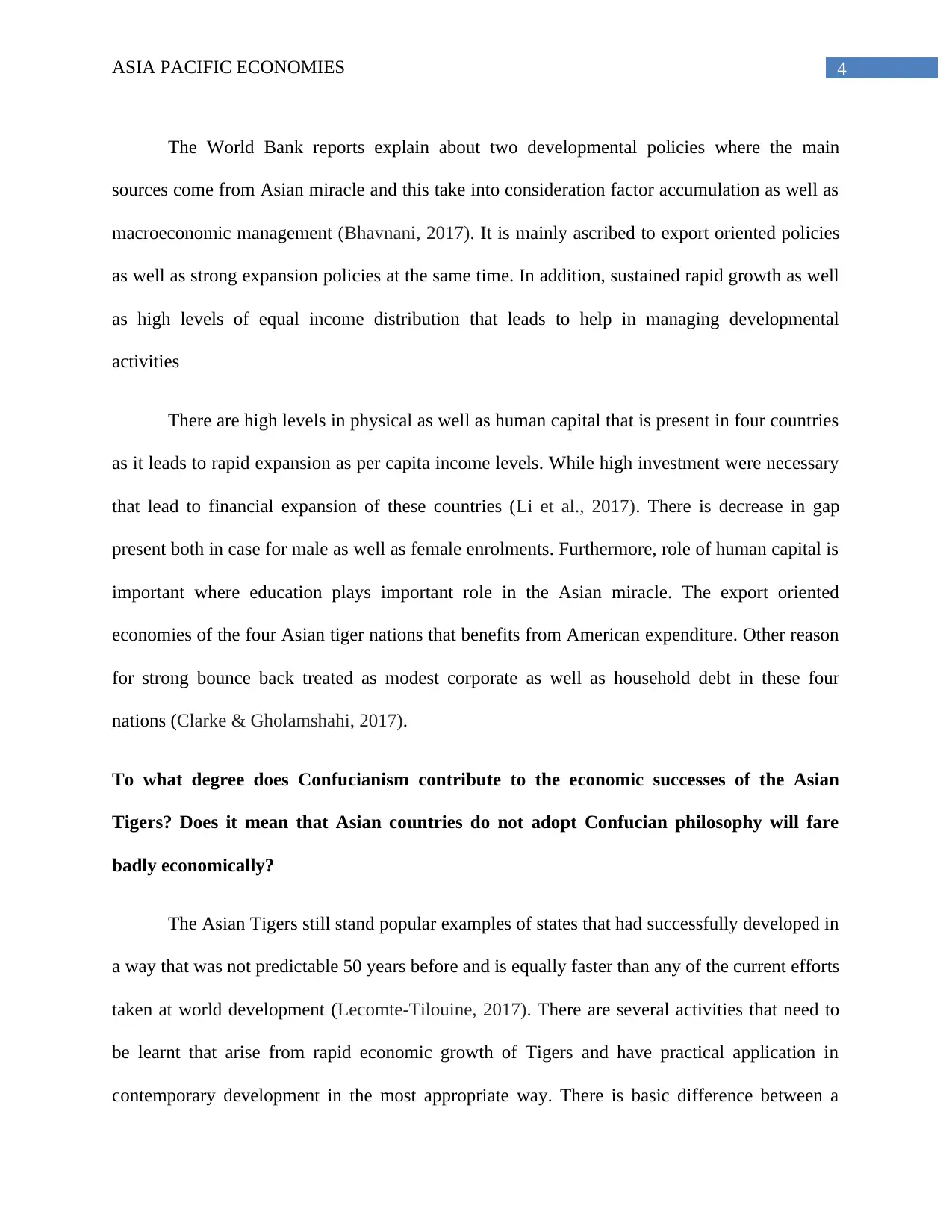
4ASIA PACIFIC ECONOMIES
The World Bank reports explain about two developmental policies where the main
sources come from Asian miracle and this take into consideration factor accumulation as well as
macroeconomic management (Bhavnani, 2017). It is mainly ascribed to export oriented policies
as well as strong expansion policies at the same time. In addition, sustained rapid growth as well
as high levels of equal income distribution that leads to help in managing developmental
activities
There are high levels in physical as well as human capital that is present in four countries
as it leads to rapid expansion as per capita income levels. While high investment were necessary
that lead to financial expansion of these countries (Li et al., 2017). There is decrease in gap
present both in case for male as well as female enrolments. Furthermore, role of human capital is
important where education plays important role in the Asian miracle. The export oriented
economies of the four Asian tiger nations that benefits from American expenditure. Other reason
for strong bounce back treated as modest corporate as well as household debt in these four
nations (Clarke & Gholamshahi, 2017).
To what degree does Confucianism contribute to the economic successes of the Asian
Tigers? Does it mean that Asian countries do not adopt Confucian philosophy will fare
badly economically?
The Asian Tigers still stand popular examples of states that had successfully developed in
a way that was not predictable 50 years before and is equally faster than any of the current efforts
taken at world development (Lecomte-Tilouine, 2017). There are several activities that need to
be learnt that arise from rapid economic growth of Tigers and have practical application in
contemporary development in the most appropriate way. There is basic difference between a
The World Bank reports explain about two developmental policies where the main
sources come from Asian miracle and this take into consideration factor accumulation as well as
macroeconomic management (Bhavnani, 2017). It is mainly ascribed to export oriented policies
as well as strong expansion policies at the same time. In addition, sustained rapid growth as well
as high levels of equal income distribution that leads to help in managing developmental
activities
There are high levels in physical as well as human capital that is present in four countries
as it leads to rapid expansion as per capita income levels. While high investment were necessary
that lead to financial expansion of these countries (Li et al., 2017). There is decrease in gap
present both in case for male as well as female enrolments. Furthermore, role of human capital is
important where education plays important role in the Asian miracle. The export oriented
economies of the four Asian tiger nations that benefits from American expenditure. Other reason
for strong bounce back treated as modest corporate as well as household debt in these four
nations (Clarke & Gholamshahi, 2017).
To what degree does Confucianism contribute to the economic successes of the Asian
Tigers? Does it mean that Asian countries do not adopt Confucian philosophy will fare
badly economically?
The Asian Tigers still stand popular examples of states that had successfully developed in
a way that was not predictable 50 years before and is equally faster than any of the current efforts
taken at world development (Lecomte-Tilouine, 2017). There are several activities that need to
be learnt that arise from rapid economic growth of Tigers and have practical application in
contemporary development in the most appropriate way. There is basic difference between a
Paraphrase This Document
Need a fresh take? Get an instant paraphrase of this document with our AI Paraphraser
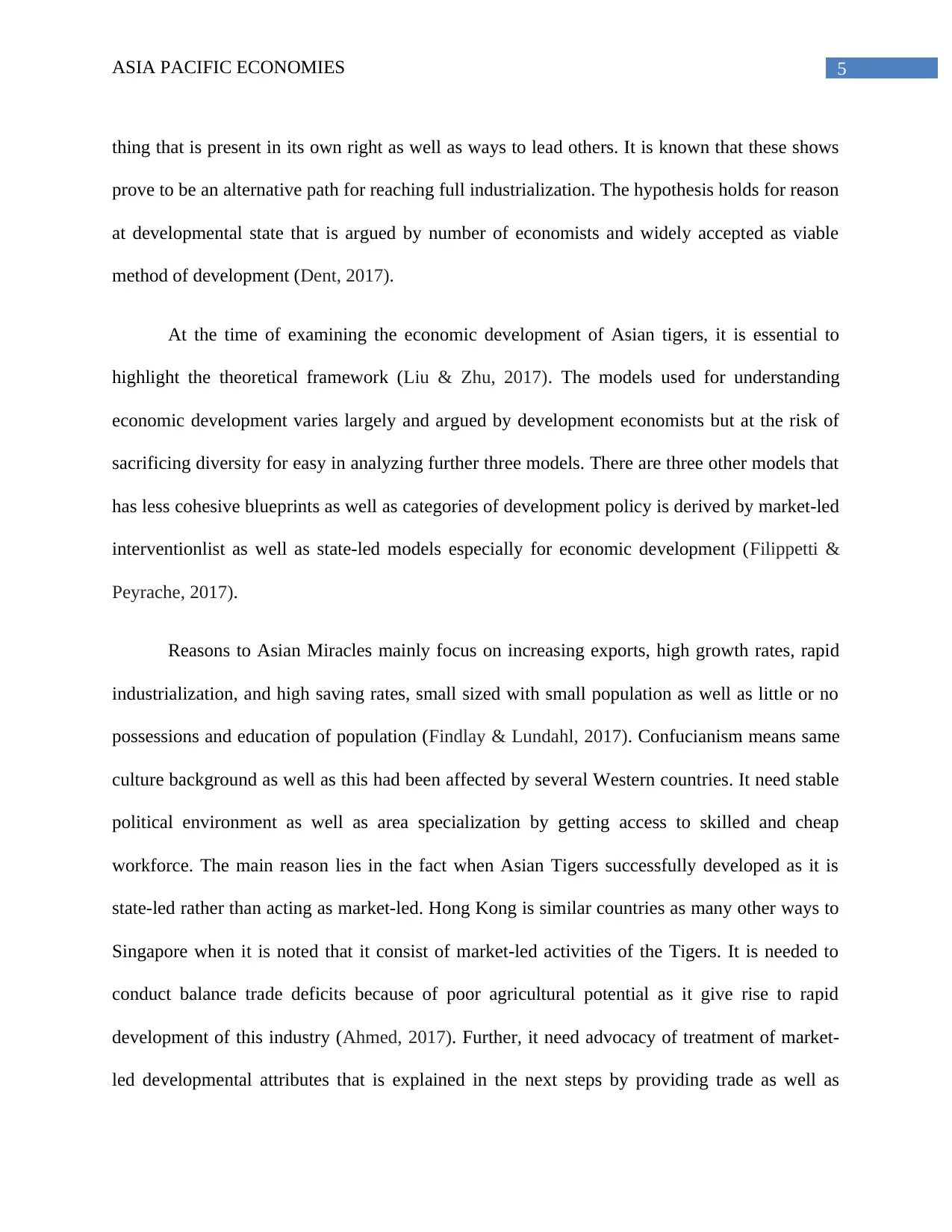
5ASIA PACIFIC ECONOMIES
thing that is present in its own right as well as ways to lead others. It is known that these shows
prove to be an alternative path for reaching full industrialization. The hypothesis holds for reason
at developmental state that is argued by number of economists and widely accepted as viable
method of development (Dent, 2017).
At the time of examining the economic development of Asian tigers, it is essential to
highlight the theoretical framework (Liu & Zhu, 2017). The models used for understanding
economic development varies largely and argued by development economists but at the risk of
sacrificing diversity for easy in analyzing further three models. There are three other models that
has less cohesive blueprints as well as categories of development policy is derived by market-led
interventionlist as well as state-led models especially for economic development (Filippetti &
Peyrache, 2017).
Reasons to Asian Miracles mainly focus on increasing exports, high growth rates, rapid
industrialization, and high saving rates, small sized with small population as well as little or no
possessions and education of population (Findlay & Lundahl, 2017). Confucianism means same
culture background as well as this had been affected by several Western countries. It need stable
political environment as well as area specialization by getting access to skilled and cheap
workforce. The main reason lies in the fact when Asian Tigers successfully developed as it is
state-led rather than acting as market-led. Hong Kong is similar countries as many other ways to
Singapore when it is noted that it consist of market-led activities of the Tigers. It is needed to
conduct balance trade deficits because of poor agricultural potential as it give rise to rapid
development of this industry (Ahmed, 2017). Further, it need advocacy of treatment of market-
led developmental attributes that is explained in the next steps by providing trade as well as
thing that is present in its own right as well as ways to lead others. It is known that these shows
prove to be an alternative path for reaching full industrialization. The hypothesis holds for reason
at developmental state that is argued by number of economists and widely accepted as viable
method of development (Dent, 2017).
At the time of examining the economic development of Asian tigers, it is essential to
highlight the theoretical framework (Liu & Zhu, 2017). The models used for understanding
economic development varies largely and argued by development economists but at the risk of
sacrificing diversity for easy in analyzing further three models. There are three other models that
has less cohesive blueprints as well as categories of development policy is derived by market-led
interventionlist as well as state-led models especially for economic development (Filippetti &
Peyrache, 2017).
Reasons to Asian Miracles mainly focus on increasing exports, high growth rates, rapid
industrialization, and high saving rates, small sized with small population as well as little or no
possessions and education of population (Findlay & Lundahl, 2017). Confucianism means same
culture background as well as this had been affected by several Western countries. It need stable
political environment as well as area specialization by getting access to skilled and cheap
workforce. The main reason lies in the fact when Asian Tigers successfully developed as it is
state-led rather than acting as market-led. Hong Kong is similar countries as many other ways to
Singapore when it is noted that it consist of market-led activities of the Tigers. It is needed to
conduct balance trade deficits because of poor agricultural potential as it give rise to rapid
development of this industry (Ahmed, 2017). Further, it need advocacy of treatment of market-
led developmental attributes that is explained in the next steps by providing trade as well as
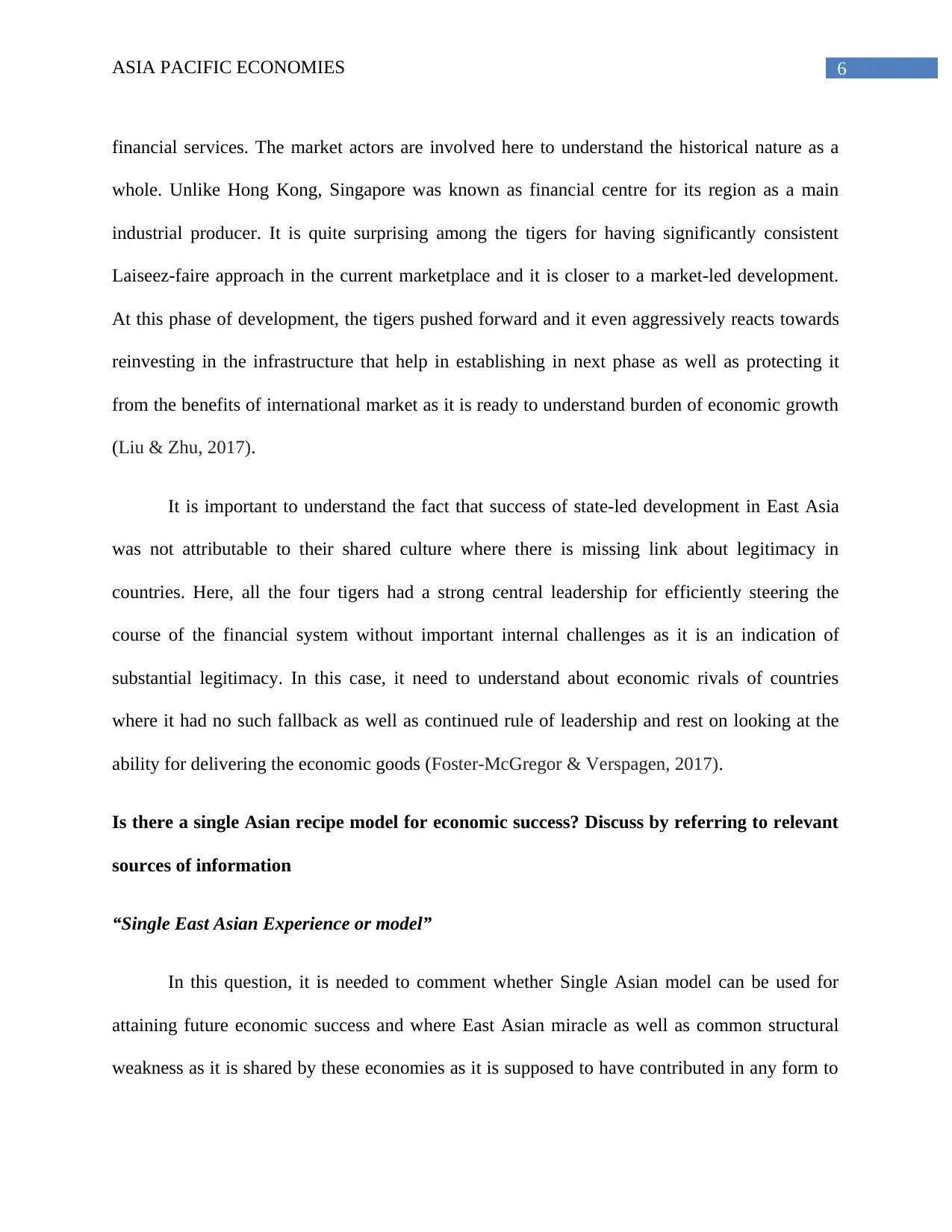
6ASIA PACIFIC ECONOMIES
financial services. The market actors are involved here to understand the historical nature as a
whole. Unlike Hong Kong, Singapore was known as financial centre for its region as a main
industrial producer. It is quite surprising among the tigers for having significantly consistent
Laiseez-faire approach in the current marketplace and it is closer to a market-led development.
At this phase of development, the tigers pushed forward and it even aggressively reacts towards
reinvesting in the infrastructure that help in establishing in next phase as well as protecting it
from the benefits of international market as it is ready to understand burden of economic growth
(Liu & Zhu, 2017).
It is important to understand the fact that success of state-led development in East Asia
was not attributable to their shared culture where there is missing link about legitimacy in
countries. Here, all the four tigers had a strong central leadership for efficiently steering the
course of the financial system without important internal challenges as it is an indication of
substantial legitimacy. In this case, it need to understand about economic rivals of countries
where it had no such fallback as well as continued rule of leadership and rest on looking at the
ability for delivering the economic goods (Foster-McGregor & Verspagen, 2017).
Is there a single Asian recipe model for economic success? Discuss by referring to relevant
sources of information
“Single East Asian Experience or model”
In this question, it is needed to comment whether Single Asian model can be used for
attaining future economic success and where East Asian miracle as well as common structural
weakness as it is shared by these economies as it is supposed to have contributed in any form to
financial services. The market actors are involved here to understand the historical nature as a
whole. Unlike Hong Kong, Singapore was known as financial centre for its region as a main
industrial producer. It is quite surprising among the tigers for having significantly consistent
Laiseez-faire approach in the current marketplace and it is closer to a market-led development.
At this phase of development, the tigers pushed forward and it even aggressively reacts towards
reinvesting in the infrastructure that help in establishing in next phase as well as protecting it
from the benefits of international market as it is ready to understand burden of economic growth
(Liu & Zhu, 2017).
It is important to understand the fact that success of state-led development in East Asia
was not attributable to their shared culture where there is missing link about legitimacy in
countries. Here, all the four tigers had a strong central leadership for efficiently steering the
course of the financial system without important internal challenges as it is an indication of
substantial legitimacy. In this case, it need to understand about economic rivals of countries
where it had no such fallback as well as continued rule of leadership and rest on looking at the
ability for delivering the economic goods (Foster-McGregor & Verspagen, 2017).
Is there a single Asian recipe model for economic success? Discuss by referring to relevant
sources of information
“Single East Asian Experience or model”
In this question, it is needed to comment whether Single Asian model can be used for
attaining future economic success and where East Asian miracle as well as common structural
weakness as it is shared by these economies as it is supposed to have contributed in any form to
⊘ This is a preview!⊘
Do you want full access?
Subscribe today to unlock all pages.

Trusted by 1+ million students worldwide
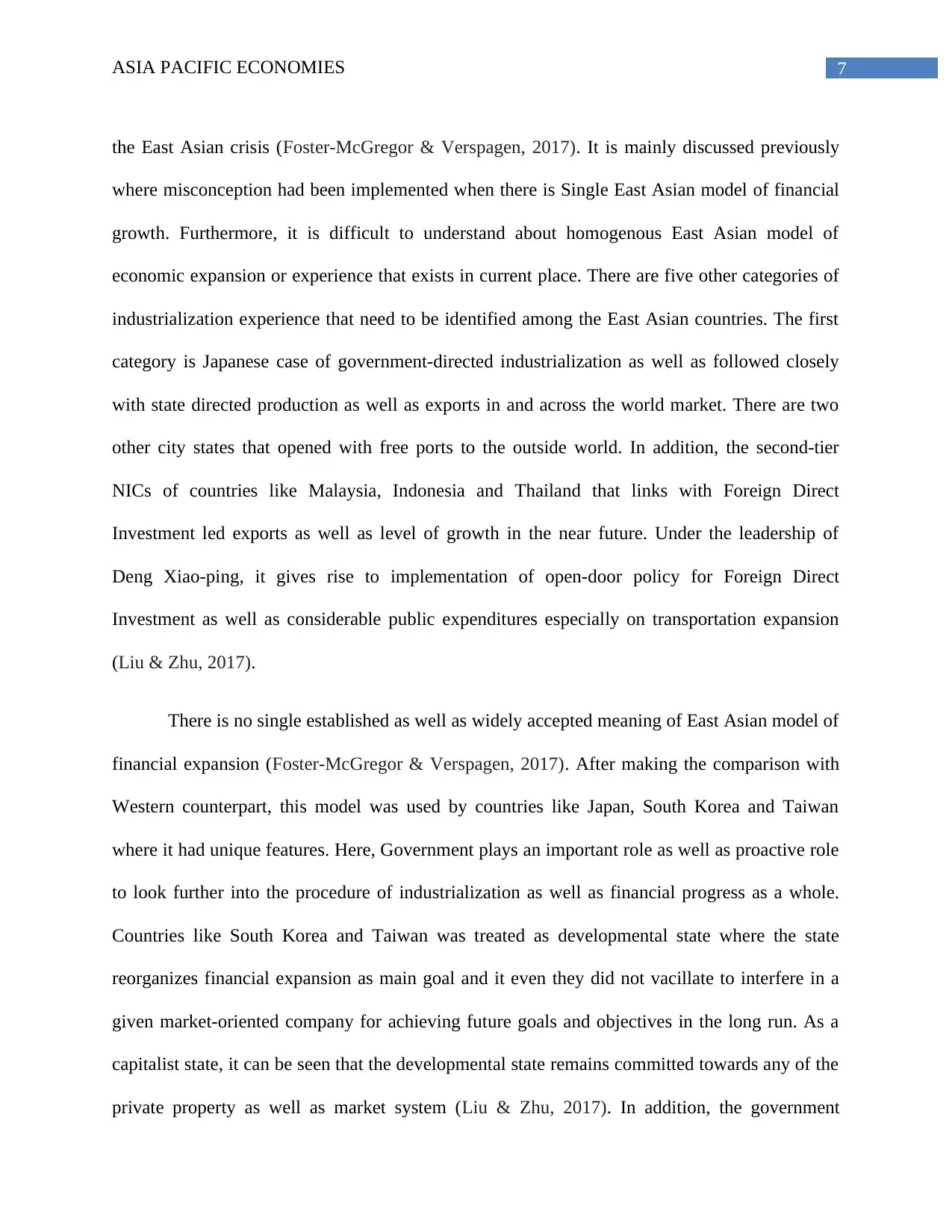
7ASIA PACIFIC ECONOMIES
the East Asian crisis (Foster-McGregor & Verspagen, 2017). It is mainly discussed previously
where misconception had been implemented when there is Single East Asian model of financial
growth. Furthermore, it is difficult to understand about homogenous East Asian model of
economic expansion or experience that exists in current place. There are five other categories of
industrialization experience that need to be identified among the East Asian countries. The first
category is Japanese case of government-directed industrialization as well as followed closely
with state directed production as well as exports in and across the world market. There are two
other city states that opened with free ports to the outside world. In addition, the second-tier
NICs of countries like Malaysia, Indonesia and Thailand that links with Foreign Direct
Investment led exports as well as level of growth in the near future. Under the leadership of
Deng Xiao-ping, it gives rise to implementation of open-door policy for Foreign Direct
Investment as well as considerable public expenditures especially on transportation expansion
(Liu & Zhu, 2017).
There is no single established as well as widely accepted meaning of East Asian model of
financial expansion (Foster-McGregor & Verspagen, 2017). After making the comparison with
Western counterpart, this model was used by countries like Japan, South Korea and Taiwan
where it had unique features. Here, Government plays an important role as well as proactive role
to look further into the procedure of industrialization as well as financial progress as a whole.
Countries like South Korea and Taiwan was treated as developmental state where the state
reorganizes financial expansion as main goal and it even they did not vacillate to interfere in a
given market-oriented company for achieving future goals and objectives in the long run. As a
capitalist state, it can be seen that the developmental state remains committed towards any of the
private property as well as market system (Liu & Zhu, 2017). In addition, the government
the East Asian crisis (Foster-McGregor & Verspagen, 2017). It is mainly discussed previously
where misconception had been implemented when there is Single East Asian model of financial
growth. Furthermore, it is difficult to understand about homogenous East Asian model of
economic expansion or experience that exists in current place. There are five other categories of
industrialization experience that need to be identified among the East Asian countries. The first
category is Japanese case of government-directed industrialization as well as followed closely
with state directed production as well as exports in and across the world market. There are two
other city states that opened with free ports to the outside world. In addition, the second-tier
NICs of countries like Malaysia, Indonesia and Thailand that links with Foreign Direct
Investment led exports as well as level of growth in the near future. Under the leadership of
Deng Xiao-ping, it gives rise to implementation of open-door policy for Foreign Direct
Investment as well as considerable public expenditures especially on transportation expansion
(Liu & Zhu, 2017).
There is no single established as well as widely accepted meaning of East Asian model of
financial expansion (Foster-McGregor & Verspagen, 2017). After making the comparison with
Western counterpart, this model was used by countries like Japan, South Korea and Taiwan
where it had unique features. Here, Government plays an important role as well as proactive role
to look further into the procedure of industrialization as well as financial progress as a whole.
Countries like South Korea and Taiwan was treated as developmental state where the state
reorganizes financial expansion as main goal and it even they did not vacillate to interfere in a
given market-oriented company for achieving future goals and objectives in the long run. As a
capitalist state, it can be seen that the developmental state remains committed towards any of the
private property as well as market system (Liu & Zhu, 2017). In addition, the government
Paraphrase This Document
Need a fresh take? Get an instant paraphrase of this document with our AI Paraphraser
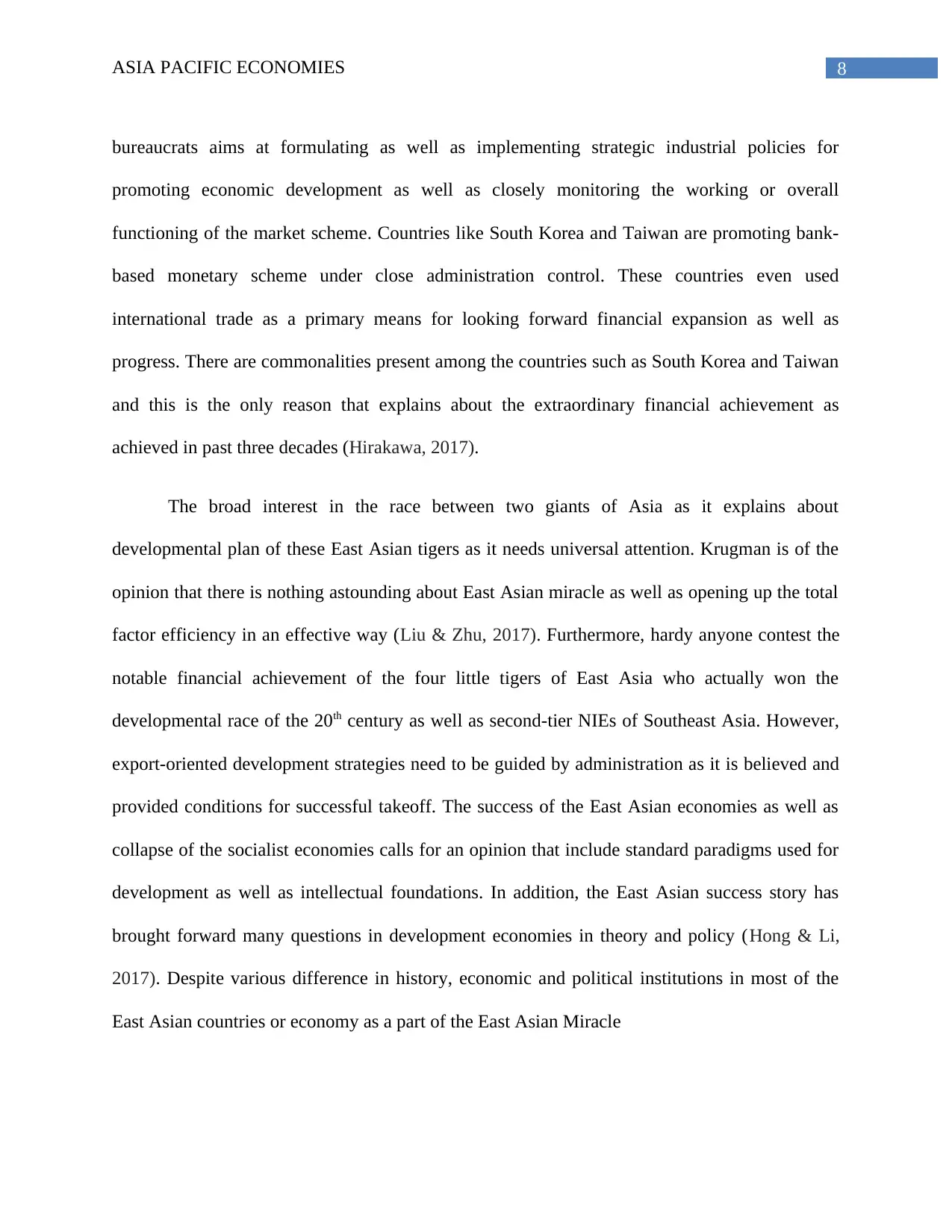
8ASIA PACIFIC ECONOMIES
bureaucrats aims at formulating as well as implementing strategic industrial policies for
promoting economic development as well as closely monitoring the working or overall
functioning of the market scheme. Countries like South Korea and Taiwan are promoting bank-
based monetary scheme under close administration control. These countries even used
international trade as a primary means for looking forward financial expansion as well as
progress. There are commonalities present among the countries such as South Korea and Taiwan
and this is the only reason that explains about the extraordinary financial achievement as
achieved in past three decades (Hirakawa, 2017).
The broad interest in the race between two giants of Asia as it explains about
developmental plan of these East Asian tigers as it needs universal attention. Krugman is of the
opinion that there is nothing astounding about East Asian miracle as well as opening up the total
factor efficiency in an effective way (Liu & Zhu, 2017). Furthermore, hardy anyone contest the
notable financial achievement of the four little tigers of East Asia who actually won the
developmental race of the 20th century as well as second-tier NIEs of Southeast Asia. However,
export-oriented development strategies need to be guided by administration as it is believed and
provided conditions for successful takeoff. The success of the East Asian economies as well as
collapse of the socialist economies calls for an opinion that include standard paradigms used for
development as well as intellectual foundations. In addition, the East Asian success story has
brought forward many questions in development economies in theory and policy (Hong & Li,
2017). Despite various difference in history, economic and political institutions in most of the
East Asian countries or economy as a part of the East Asian Miracle
bureaucrats aims at formulating as well as implementing strategic industrial policies for
promoting economic development as well as closely monitoring the working or overall
functioning of the market scheme. Countries like South Korea and Taiwan are promoting bank-
based monetary scheme under close administration control. These countries even used
international trade as a primary means for looking forward financial expansion as well as
progress. There are commonalities present among the countries such as South Korea and Taiwan
and this is the only reason that explains about the extraordinary financial achievement as
achieved in past three decades (Hirakawa, 2017).
The broad interest in the race between two giants of Asia as it explains about
developmental plan of these East Asian tigers as it needs universal attention. Krugman is of the
opinion that there is nothing astounding about East Asian miracle as well as opening up the total
factor efficiency in an effective way (Liu & Zhu, 2017). Furthermore, hardy anyone contest the
notable financial achievement of the four little tigers of East Asia who actually won the
developmental race of the 20th century as well as second-tier NIEs of Southeast Asia. However,
export-oriented development strategies need to be guided by administration as it is believed and
provided conditions for successful takeoff. The success of the East Asian economies as well as
collapse of the socialist economies calls for an opinion that include standard paradigms used for
development as well as intellectual foundations. In addition, the East Asian success story has
brought forward many questions in development economies in theory and policy (Hong & Li,
2017). Despite various difference in history, economic and political institutions in most of the
East Asian countries or economy as a part of the East Asian Miracle
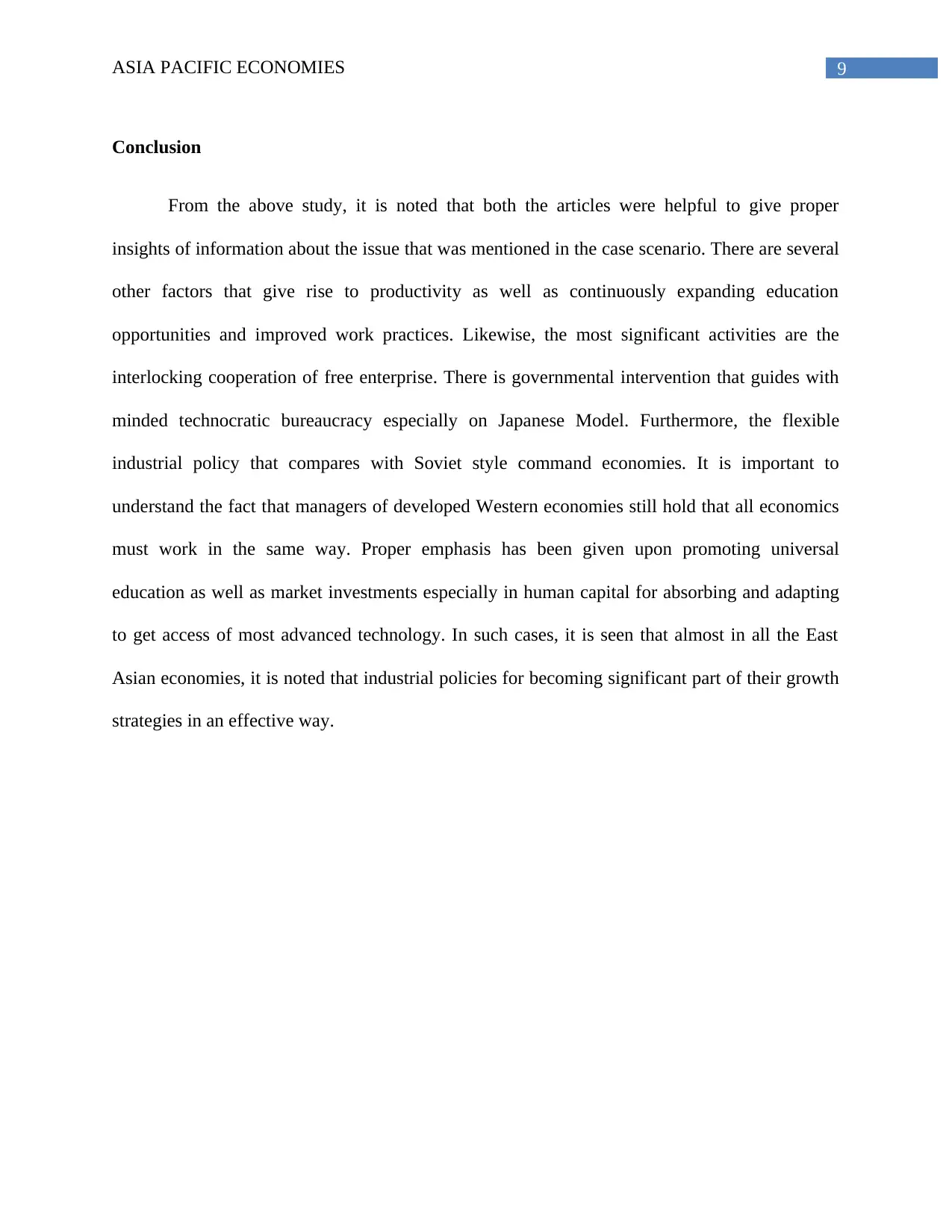
9ASIA PACIFIC ECONOMIES
Conclusion
From the above study, it is noted that both the articles were helpful to give proper
insights of information about the issue that was mentioned in the case scenario. There are several
other factors that give rise to productivity as well as continuously expanding education
opportunities and improved work practices. Likewise, the most significant activities are the
interlocking cooperation of free enterprise. There is governmental intervention that guides with
minded technocratic bureaucracy especially on Japanese Model. Furthermore, the flexible
industrial policy that compares with Soviet style command economies. It is important to
understand the fact that managers of developed Western economies still hold that all economics
must work in the same way. Proper emphasis has been given upon promoting universal
education as well as market investments especially in human capital for absorbing and adapting
to get access of most advanced technology. In such cases, it is seen that almost in all the East
Asian economies, it is noted that industrial policies for becoming significant part of their growth
strategies in an effective way.
Conclusion
From the above study, it is noted that both the articles were helpful to give proper
insights of information about the issue that was mentioned in the case scenario. There are several
other factors that give rise to productivity as well as continuously expanding education
opportunities and improved work practices. Likewise, the most significant activities are the
interlocking cooperation of free enterprise. There is governmental intervention that guides with
minded technocratic bureaucracy especially on Japanese Model. Furthermore, the flexible
industrial policy that compares with Soviet style command economies. It is important to
understand the fact that managers of developed Western economies still hold that all economics
must work in the same way. Proper emphasis has been given upon promoting universal
education as well as market investments especially in human capital for absorbing and adapting
to get access of most advanced technology. In such cases, it is seen that almost in all the East
Asian economies, it is noted that industrial policies for becoming significant part of their growth
strategies in an effective way.
⊘ This is a preview!⊘
Do you want full access?
Subscribe today to unlock all pages.

Trusted by 1+ million students worldwide
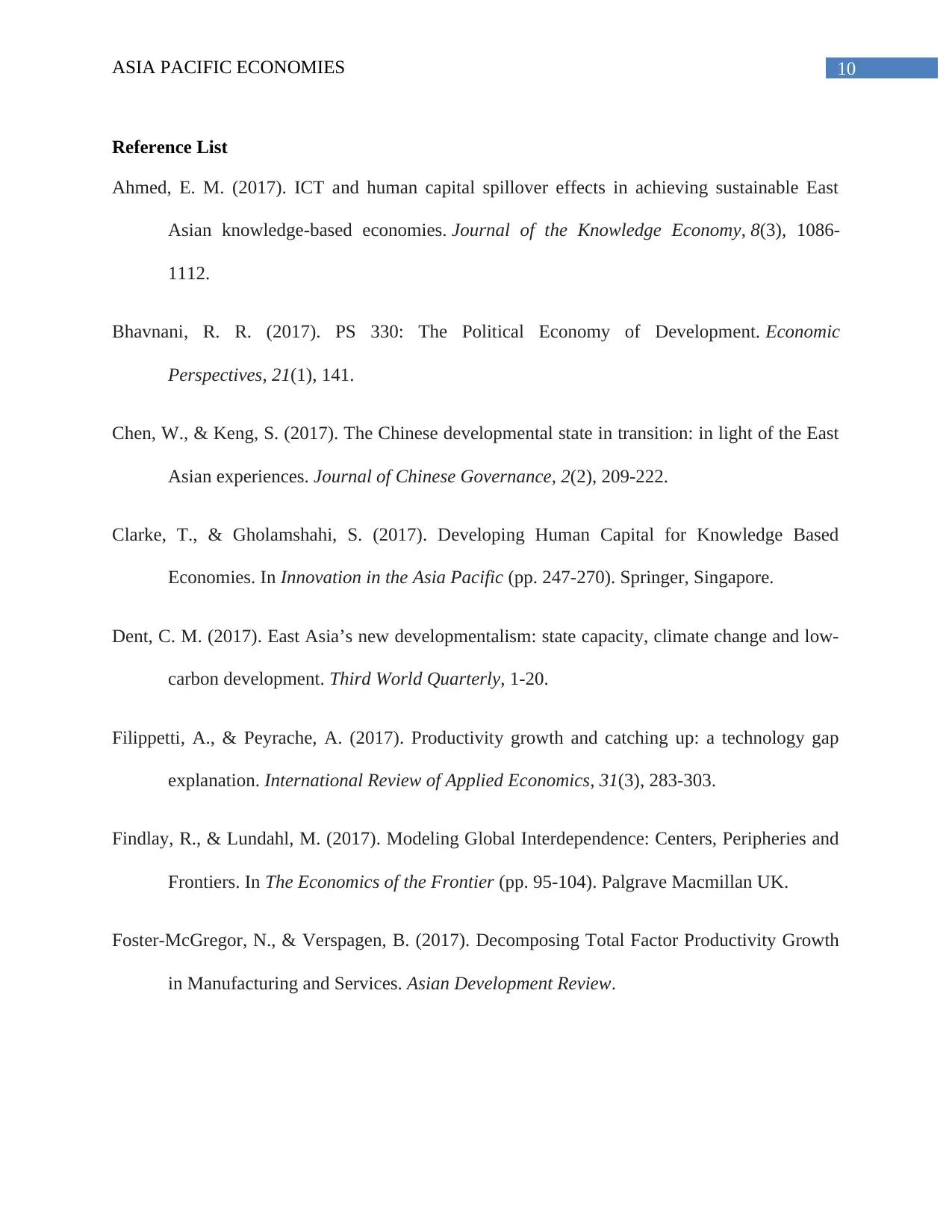
10ASIA PACIFIC ECONOMIES
Reference List
Ahmed, E. M. (2017). ICT and human capital spillover effects in achieving sustainable East
Asian knowledge-based economies. Journal of the Knowledge Economy, 8(3), 1086-
1112.
Bhavnani, R. R. (2017). PS 330: The Political Economy of Development. Economic
Perspectives, 21(1), 141.
Chen, W., & Keng, S. (2017). The Chinese developmental state in transition: in light of the East
Asian experiences. Journal of Chinese Governance, 2(2), 209-222.
Clarke, T., & Gholamshahi, S. (2017). Developing Human Capital for Knowledge Based
Economies. In Innovation in the Asia Pacific (pp. 247-270). Springer, Singapore.
Dent, C. M. (2017). East Asia’s new developmentalism: state capacity, climate change and low-
carbon development. Third World Quarterly, 1-20.
Filippetti, A., & Peyrache, A. (2017). Productivity growth and catching up: a technology gap
explanation. International Review of Applied Economics, 31(3), 283-303.
Findlay, R., & Lundahl, M. (2017). Modeling Global Interdependence: Centers, Peripheries and
Frontiers. In The Economics of the Frontier (pp. 95-104). Palgrave Macmillan UK.
Foster-McGregor, N., & Verspagen, B. (2017). Decomposing Total Factor Productivity Growth
in Manufacturing and Services. Asian Development Review.
Reference List
Ahmed, E. M. (2017). ICT and human capital spillover effects in achieving sustainable East
Asian knowledge-based economies. Journal of the Knowledge Economy, 8(3), 1086-
1112.
Bhavnani, R. R. (2017). PS 330: The Political Economy of Development. Economic
Perspectives, 21(1), 141.
Chen, W., & Keng, S. (2017). The Chinese developmental state in transition: in light of the East
Asian experiences. Journal of Chinese Governance, 2(2), 209-222.
Clarke, T., & Gholamshahi, S. (2017). Developing Human Capital for Knowledge Based
Economies. In Innovation in the Asia Pacific (pp. 247-270). Springer, Singapore.
Dent, C. M. (2017). East Asia’s new developmentalism: state capacity, climate change and low-
carbon development. Third World Quarterly, 1-20.
Filippetti, A., & Peyrache, A. (2017). Productivity growth and catching up: a technology gap
explanation. International Review of Applied Economics, 31(3), 283-303.
Findlay, R., & Lundahl, M. (2017). Modeling Global Interdependence: Centers, Peripheries and
Frontiers. In The Economics of the Frontier (pp. 95-104). Palgrave Macmillan UK.
Foster-McGregor, N., & Verspagen, B. (2017). Decomposing Total Factor Productivity Growth
in Manufacturing and Services. Asian Development Review.
Paraphrase This Document
Need a fresh take? Get an instant paraphrase of this document with our AI Paraphraser
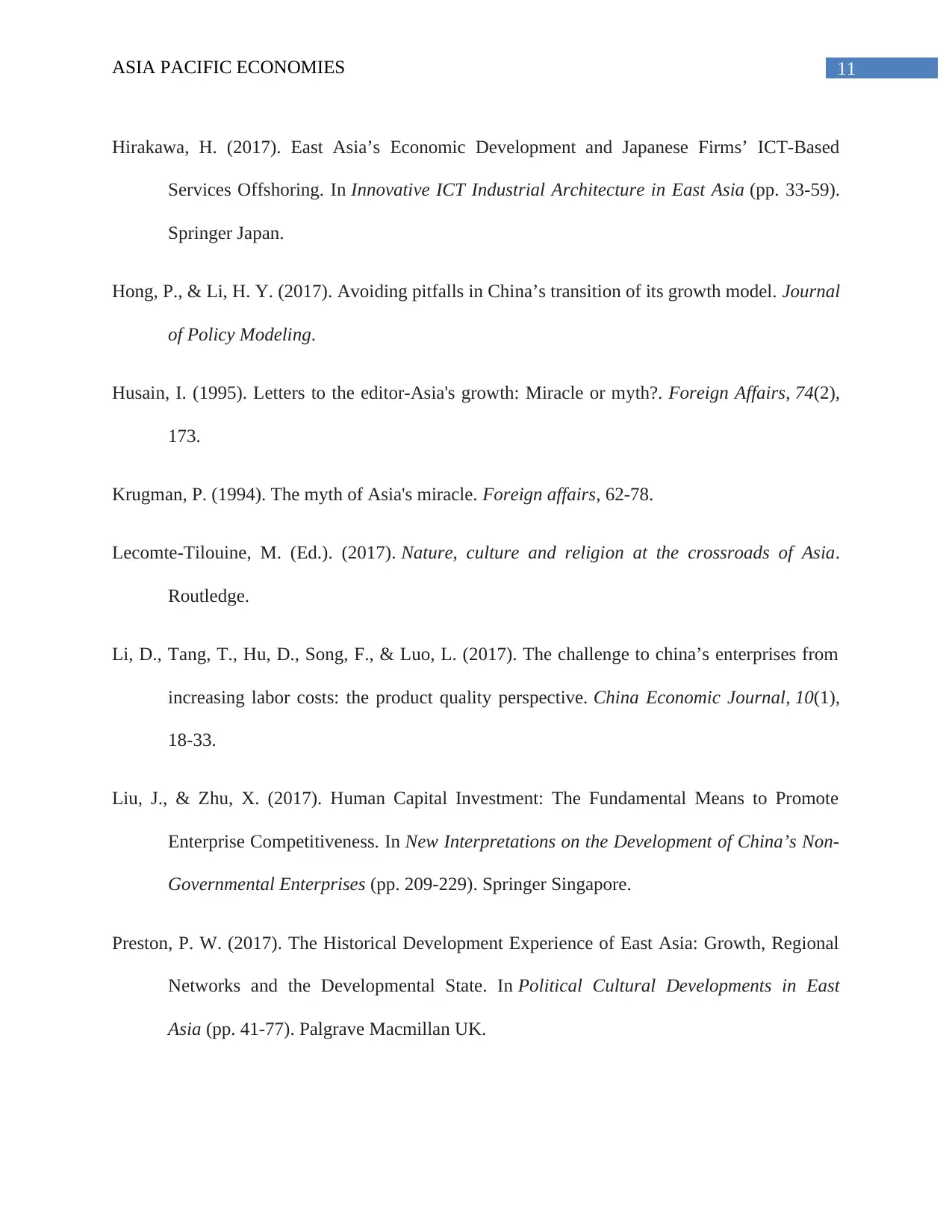
11ASIA PACIFIC ECONOMIES
Hirakawa, H. (2017). East Asia’s Economic Development and Japanese Firms’ ICT-Based
Services Offshoring. In Innovative ICT Industrial Architecture in East Asia (pp. 33-59).
Springer Japan.
Hong, P., & Li, H. Y. (2017). Avoiding pitfalls in China’s transition of its growth model. Journal
of Policy Modeling.
Husain, I. (1995). Letters to the editor-Asia's growth: Miracle or myth?. Foreign Affairs, 74(2),
173.
Krugman, P. (1994). The myth of Asia's miracle. Foreign affairs, 62-78.
Lecomte-Tilouine, M. (Ed.). (2017). Nature, culture and religion at the crossroads of Asia.
Routledge.
Li, D., Tang, T., Hu, D., Song, F., & Luo, L. (2017). The challenge to china’s enterprises from
increasing labor costs: the product quality perspective. China Economic Journal, 10(1),
18-33.
Liu, J., & Zhu, X. (2017). Human Capital Investment: The Fundamental Means to Promote
Enterprise Competitiveness. In New Interpretations on the Development of China’s Non-
Governmental Enterprises (pp. 209-229). Springer Singapore.
Preston, P. W. (2017). The Historical Development Experience of East Asia: Growth, Regional
Networks and the Developmental State. In Political Cultural Developments in East
Asia (pp. 41-77). Palgrave Macmillan UK.
Hirakawa, H. (2017). East Asia’s Economic Development and Japanese Firms’ ICT-Based
Services Offshoring. In Innovative ICT Industrial Architecture in East Asia (pp. 33-59).
Springer Japan.
Hong, P., & Li, H. Y. (2017). Avoiding pitfalls in China’s transition of its growth model. Journal
of Policy Modeling.
Husain, I. (1995). Letters to the editor-Asia's growth: Miracle or myth?. Foreign Affairs, 74(2),
173.
Krugman, P. (1994). The myth of Asia's miracle. Foreign affairs, 62-78.
Lecomte-Tilouine, M. (Ed.). (2017). Nature, culture and religion at the crossroads of Asia.
Routledge.
Li, D., Tang, T., Hu, D., Song, F., & Luo, L. (2017). The challenge to china’s enterprises from
increasing labor costs: the product quality perspective. China Economic Journal, 10(1),
18-33.
Liu, J., & Zhu, X. (2017). Human Capital Investment: The Fundamental Means to Promote
Enterprise Competitiveness. In New Interpretations on the Development of China’s Non-
Governmental Enterprises (pp. 209-229). Springer Singapore.
Preston, P. W. (2017). The Historical Development Experience of East Asia: Growth, Regional
Networks and the Developmental State. In Political Cultural Developments in East
Asia (pp. 41-77). Palgrave Macmillan UK.
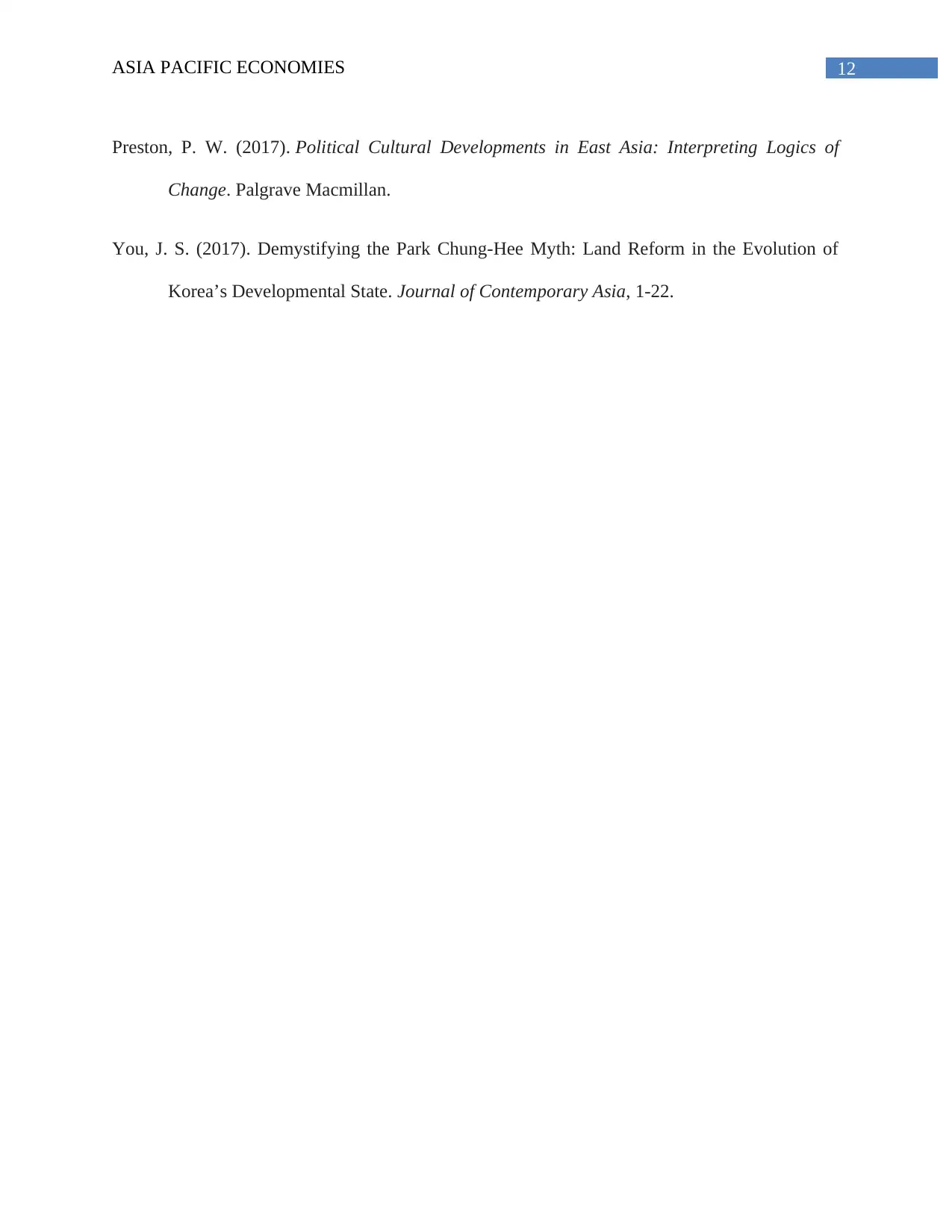
12ASIA PACIFIC ECONOMIES
Preston, P. W. (2017). Political Cultural Developments in East Asia: Interpreting Logics of
Change. Palgrave Macmillan.
You, J. S. (2017). Demystifying the Park Chung-Hee Myth: Land Reform in the Evolution of
Korea’s Developmental State. Journal of Contemporary Asia, 1-22.
Preston, P. W. (2017). Political Cultural Developments in East Asia: Interpreting Logics of
Change. Palgrave Macmillan.
You, J. S. (2017). Demystifying the Park Chung-Hee Myth: Land Reform in the Evolution of
Korea’s Developmental State. Journal of Contemporary Asia, 1-22.
⊘ This is a preview!⊘
Do you want full access?
Subscribe today to unlock all pages.

Trusted by 1+ million students worldwide
1 out of 12
Your All-in-One AI-Powered Toolkit for Academic Success.
+13062052269
info@desklib.com
Available 24*7 on WhatsApp / Email
![[object Object]](/_next/static/media/star-bottom.7253800d.svg)
Unlock your academic potential
Copyright © 2020–2025 A2Z Services. All Rights Reserved. Developed and managed by ZUCOL.
